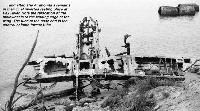Фотографии
-
Ar 234B-2 WNr 140311, formerly of II./KG 76, was handed over to the RAF at Stavanger in Norway in May 1945. Becoming USA 40, then No 404, it was transported to the USA aboard HMS Reaper and delivered to Freeman Field, where it is seen here.
Самолёты на фотографии: Arado Ar.234 Blitz - Германия - 1943
-
Captured at Grove in Denmark in 1945, this Arado Ar 234B was brought to the USA to become No 202, named Jane I. It was flown from Newark to the US Navy Flight Test Division at NAS Patuxent River, Maryland, but remained grounded owing to a lack of spares. It was struck off charge in December 1946 and dumped into the Patuxent in the early 1970s.
Самолёты на фотографии: Arado Ar.234 Blitz - Германия - 1943
-
An ignominious ending for the Airabonita, seen here inverted, and one of the Ar 234Bs, in a photo taken at Pax River at low tide in 1976.
Самолёты на фотографии: Arado Ar.234 Blitz - Германия - 1943Bell XFL-1 Airabonita - США - 1940
-
LEFT The remains of one of the Ar 234’s Junkers Jumo 004B axiai-fiow turbojet engines at Pax River in the spring of 1976. The photographs show that despite their rough treatment, the airframes were in relatively good condition. RIGHT The empennage of one of the Ar 234s. The swastika on the fin has been “souvenired”.
Самолёты на фотографии: Arado Ar.234 Blitz - Германия - 1943
-
One of the Ar 234s looking as though it is trying to claw its way back to the top of the riverbank. The jet bomber’s back was broken as a result of having been pushed backwards off the escarpment. To view the exact location of the site, enter the following coordinates in the “Fly to” box in Google Earth: 38.304301, -76.41621.
Самолёты на фотографии: Arado Ar.234 Blitz - Германия - 1943
-
Sharing the same section of shoreline in this photo taken by Chris Koberg in 1976 are one of the Ar 234Bs and the Bell XFL-1 Airabonita, both slowly becoming obscured as soil is dumped over the escarpment in attempts to stabilise the riverbank.
Самолёты на фотографии: Arado Ar.234 Blitz - Германия - 1943Bell XFL-1 Airabonita - США - 1940
-
The XFL-1 Airabonita experimental shipboard fighter which failed carrier qualification trials.
The sole Bell XFL-1 Airabonita was plagued by engine and undercarriage problems and was passed over in favour of the Vought F4U Corsair.Самолёты на фотографии: Bell XFL-1 Airabonita - США - 1940
-
Белл XFL-1 "Аэробонита" - конкурент "Корсара"
Before ... in 1938 Bell offered a navalised version of the P-39 Airacobra, the XFL-1 Airabonita, in response to the US Navy’s request for a light high-performance shipborne fighter.Broadly similar to the P-39, the XFL-1 featured a taildragger undercarriage, taller fin, arrester hook, strengthened airframe, larger wing and shorter fuselage...Самолёты на фотографии: Bell XFL-1 Airabonita - США - 1940
-
... and after. The Airabonita’s remains in their final inverted resting place at Pax River. Note the relocation of the main wheels to the leading edge of the wing. The tube at the nose end is the control column torque tube.
Самолёты на фотографии: Bell XFL-1 Airabonita - США - 1940
Статьи
- -
- ??? - Gone Fishin'!
- A.Tincopa - Wings over Peru
- B.Dunnell - Falklands confidential
- D.Gordon, I.Bott - Days of Thunder
- E.Wild - West Africa Wins Again ... or pigs can fly
- G.Alegi - ... a 350 lb Mystery
- J.Picarella, C.Koberg - Sunken treasure?
- J.Pote - A Close Shave at Wellington
- M.Garden - Oscar Garden the Sundowner of the Skies
- N.Stroud - The Last of the Many
- P.Davidson - Off the Beaten Track...
- P.Jarrett - Pioneering the Fighter (2)
- P.Vabre - Any port in a storm ... From Qantas Empire Airways
- R.Tisdale, A.Vercamer - Before & After








